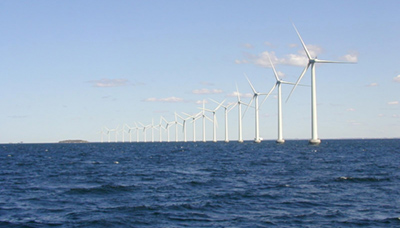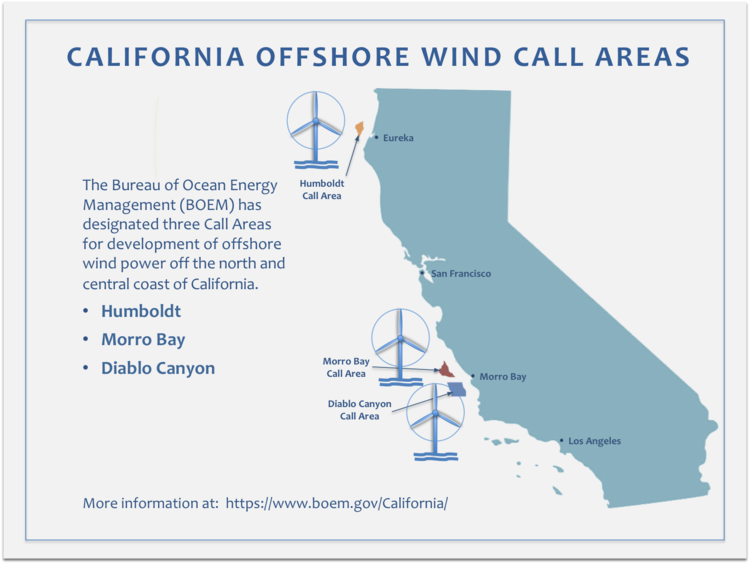
A lot has happened since the Biden administration in May 2021 announced that California’s northern and central coasts would be open to offshore wind development, identifying two areas in particular: Morro Bay and Humboldt Call.
The idea was to pursue the development of floating offshore wind platforms off the California coast as part of the Biden administration’s overall goal of generating 30 gigawatts of domestic offshore wind by 2030. The Department of the Interior’s Bureau of Ocean Energy Management (BOEM) is the lead agency on offshore wind.
This past May, the department announced offshore wind lease sales for the first time on the West Coast. The Proposed Sale Notice, published May 31 in the Federal Register, includes three proposed lease areas in the Morro Bay Wind Energy Area in central California and two proposed lease areas in the Humboldt Wind Energy Area to the north.
Combined, they represent about 373,268 acres for the potential development of more than 4.5 gigawatts of offshore wind energy—enough to power more than 1.5 million homes.
But as BOEM moves forward, concerns from the West Coast maritime community remain.
At a June 3 California Intergovernmental Renewable Energy Task Force meeting, members of the commercial fishing community were vocal about how these potential projects could affect the way they fish.
Alan Alward, secretary of the Morro Bay Commercial Fishermen’s Organization and co-chair of the Alliance of Communities for Sustainable Fisheries, said for commercial fishermen, offshore wind still has unknown risks.
“We are being asked to bear those risks and we need careful consideration,” he said.
Alward added that there are other impacts that BOEM needs to study.
“Right now, the status is that there will be no impact on commercial fishing from site survey and it is our assertion that there will be for a variety of reasons,” Alward said. “You can’t go on saying there’s no impact without looking at it.”
BOEM should also consider realigning the lease boundaries to the prevailing wind, he added.
Mike Okoniewski, a consultant for Pacific Seafood whose experience in the fish business spans more than five decades, said that the company plant in Eureka “could be hit hard enough on the groundfish side that it actually puts us out of business.”
Okoniewski also spoke of a recent study about the effects of floating offshore wind turbines on atmospheric circulation in California and its offshore waters.
“I think we all know that it is these winds that drive upwelling, which is responsible for much of the primary productivity that sustains one of the richest systems on the planet,” he said, adding that “we’re rushing ahead far too fast and have not taken into consideration hydrological and ecological impacts that may occur if we start putting up more than several wind farms.”
Mike Conroy, executive director of the Pacific Coast Federation of Fishermen’s Associations, representing nearly 900 individual fishermen and small businesses from Southern California to Alaska, echoed the sentiments.
Like many in the West Coast fishing sector, Conroy was concerned that the fishing community didn’t have a seat at the table when decisions were being made about potential sites for offshore wind development.
“We’re not opposed to offshore renewable energy, offshore wind,” Conroy said. “I think what we’re opposed to is being told where they’re going, rather (than) being asked where they could go to minimize impacts.”
Merit McCrea, a member of the Pacific Fisheries Management Council’s Groundfish Advisory Subpanel and the Board of the Coastal Conservation Association of California, suggested that BOEM approach the development of offshore wind projects in a more incremental way.
It takes more than 10 years to develop a new fishery, he added, including a trial period of that fishery through a small number of fishermen and new gear types and an approvals process.
“I’m not suggesting that it should take a full 10 years, but I am suggesting that we should proceed … in an incremental way where perhaps a few facilities are put out there,” McCrea said. “We learn from how that goes. We adjust in such a way as to generate the greatest amount of benefit for the least amount of negative impacts and move forward that way.”

‘Industry Is Upset’
The fishing community isn’t the only industry feeling left out.
Pacific Merchant Shipping Association Vice President Jacqueline Moore expressed concern at the June 3 task force meeting that the shipping industry was not brought into the conversation sooner, adding that BOEM only recently initiated a meeting, in May, at least two years after West Coast efforts had begun.
“It is a concern (that) this did not raise any red flags, as shown in the published 2018 and 2021 outreach reports, which specifically include fishing, coastal and tribal communities,” she said.
Moore added that the PMSA is frustrated that the sale-notice structure calling for the lessee to create outreach plans and set meetings, didn’t include the shipping industry.
“Our industry is upset, and certainly not to discount these stakeholders in any way—they are vital and I see them as sister stakeholders—but we simply ask for the same consideration,” Moore said.
One of PMSA’s concerns also involves BOEM’s analysis of vessel traffic in the call areas. With vessels that are more than 200,000 tons and 1,400 feet long—and some carrying hazardous materials—transiting through these lease areas becomes a safety issue, she said.
“We all want the least impactful projects, and this can be done only if accuracy, integrity are upheld,” Moore said.
Peter Schrappen, vice president of American Waterways Operators for the Pacific Coast region, representing tugboat, towboat and barge operators, also raised safety concerns at the June 3 meeting. He echoed Moore’s sentiment that the shipping industry needs to be part of the process and “vessel traffic is part of the calculations at any sale that takes place.”
“Human safety is paramount as we plan for developing future energy resources,” he said during public comment. “Put it another way: we should not jeopardize navigation safety as we develop this exciting new field of renewable energy.”
Transparency and Consistency
BOEM has been working to raise the level of transparency and consistency surrounding the matter. On June 23, the bureau standardized its process for “identifying reasonable alternatives for evaluation” in its draft Environmental Impact Statements for offshore wind development and any operations plans it receives from lessees.
The government also took in feedback from its federal partners when it finalized its “Process for Identifying Alternatives for Environmental Reviews of Offshore Wind Construction and Operations Plans Pursuant to the National Environmental Policy Act” document.
With these two actions, BOEM wanted to create “a clear framework and criteria for alternatives to be analyzed in detail, as well as alternatives considered but not analyzed in detail.”
BOEM also announced on June 23 that it is seeking feedback from the public on a “draft guidance on mitigating potential impacts of offshore wind development on commercial and recreational fishing.”
The document would help inform how offshore wind firms should proceed in developing projects in California and curb impacts to fisheries.
“We want feedback on the entirety of (the) mitigation framework, from facility design considerations to recommendations on compensatory mitigation, particularly from the people and organizations that this guidance is meant to aid,” BOEM Marine Biologist Brian Hooker said.
The public has until 9 p.m. PT on Aug. 22 to weigh in on the document. To comment, visit https://www.regulations.gov/docket/BOEM-2022-0033/document.
“Fishing communities and fisheries stakeholders are critical to our offshore energy development process, and we’re looking forward to discussions on this draft guidance,” BOEM Director Amanda Lefton said. “We’re seeking open and honest conversations focused on finding solutions to potential challenges as we work to provide clean, safe domestic energy for American taxpayers, while at the same time providing good-paying jobs and building a U.S. supply chain to support this effort.”
Meanwhile, the public has until 8:59 p.m. PT on Aug. 1 to weigh in on the proposed lease areas, lease stipulations and auction details mentioned in the Proposed Sale Notice.
BOEM particularly is looking for feedback on a 2.5% bidding credit to those who plan to have a community benefit agreement with a community or ocean users such as commercial fisheries; a project labor agreement requirement for lessees, and mandates that lessees work with tribes, ocean users and other communities to limit their projects’ impact on these groups.
Comments can be submitted at https://www.boem.gov/renewable-energy/state-activities/california.
After the feedback is gathered, it will be decided whether a final sale notice will be published. A time and date of the lease sale would be announced, as well as a list of qualified firms planning to participate.
KAREN ROBES MEEKS, a Southern California native, is an award-winning journalist with more than 20 years’ writing experience. Her articles have appeared in the Los Angeles Times, San Francisco Chronicle, Orange County Register and Long Beach Press-Telegram, where she worked as a reporter for nearly 14 years. Her work has been recognized by the California News Publishers Association, the Associated Press News Executives Council and the Los Angeles Press Club.
